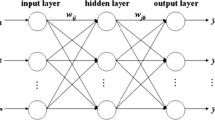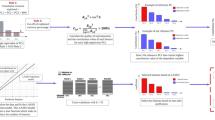Abstract
Aiming at the large sample with high feature dimension, this paper proposes a back-propagation (BP) neural network algorithm based on factor analysis (FA) and cluster analysis (CA), which is combined with the principles of FA and CA, and the architecture of BP neural network. The new algorithm reduces the feature dimensionality of the initial data through FA to simplify the network architecture; then divides the samples into different sub-categories through CA, trains the network so as to improve the adaptability of the network. In application, it is first to classify the new samples, then using the corresponding network to predict. By an experiment, the new algorithm is significantly improved at the aspect of its prediction precision. In order to test and verify the validity of the new algorithm, we compare it with BP algorithms based on FA and CA.


Similar content being viewed by others
References
Mccllochw S, Pitts W (1943) A logical calculus of the ideas immanent in nervous activity. Bull Math Biophys 10(5):115–133
Pradhan B, Lee S (2007) Utilization of optical remote sensing data and GIS tools for regional landslide hazard analysis by using an artificial neural network model. Earth Sci Frontier 14(6):143–152
Pradhan B, Lee S (2010) Landslide susceptibility assessment and factor effect analysis: backpropagation artificial neural networks and their comparison with frequency ratio and bivariate logistic regression modelling. Environ Model Softw 25(6):747–759
Pradhan B, Lee S (2009) Landslide risk analysis using artificial neural network model focusing on different training sites. Int J Phys Sci 3(11):1–15
Cheng H, Cai X, Min R (2009) A novel approach to color normalization using neural network. Neural Comput Appl 18(3):237–247
Rumelhart D, Hinton G, Williams R (1986) Learning representation by back-propagating errors. Nature 3(6):533–536
Zhang Y (2007) Artificial neural networks based on principal component analysis input selection for clinical pattern recognition analysis. Talanta 73(1):68–75
Lewis E, Sheridan C, Farrell M et al (2007) Principal component analysis and artificial neural network based approach to analysing optical fibre sensors signals. Sens Actuators A Phys 136(1):28–38
He F, Qi H (2007) Nonlinear evaluation model based on principal component analysis and neural network. J Wuhan Uni Techn 29(8):183–186
Melchiorre C, Matteucci M, Azzoni A et al (2008) Artificial neural networks and cluster analysis in landslide susceptibility zonation. Geomorphology 94(3–4):379–400
Lin S, Zhang D, Li W et al (2005) Neural network forecasting model based on clustering and principle components analysis. Mini-Micro Syst 26(12):2160–2163
Gopi E (2007) Digital image forgery detection using artificial neural network and independent component analysis. Appl Math Comput 194(2):540–543
Song J, Feng Y (2006) Hyperspectral data classification by independent component analysis and neural network. Remote Sens Techn Appl 21(2):115–119
Pan Z, Pan D, Sun P et al (1997) Spectroscopic quantitation of amino acids by using artificial neural networks combined with factor analysis. Spectrochim Acta Part A Mol Biomol Spectrosc 53(10):1629–1632
Janes K, Yang S, Hacker R (2005) Pork farm odour modelling using multiple-component multiple-factor analysis and neural networks. Appl Soft Comput 6(1):53–61
Huo W (2007) Research on BP neural network based on factor analysis and its application in rational synthesis of microporous materials. Jilin University, Jilin
Anderson T (1984) An introduction to multivariate statistical analysis, 2nd edn. Wiley, New York
Speraman C (1904) General intelligence objectively determined and measured. Am J Psychol 15:201–293
Shi Z (2009) Neural network. Higher Education Press, Beijing
Zhang Y (2003) The application of artificial neural network in the forecasting of wheat midge. Northwest A&F University, Xianyang
Acknowledgments
This work is supported by the Basic Research Program (Natural Science Foundation) of Jiangsu Province of China under grant no. BK2009093, and the National Nature Science Foundation of China under grant no. 60975039.
Author information
Authors and Affiliations
Corresponding author
Rights and permissions
About this article
Cite this article
Ding, S., Jia, W., Su, C. et al. Research of neural network algorithm based on factor analysis and cluster analysis. Neural Comput & Applic 20, 297–302 (2011). https://doi.org/10.1007/s00521-010-0416-2
Received:
Accepted:
Published:
Issue Date:
DOI: https://doi.org/10.1007/s00521-010-0416-2




